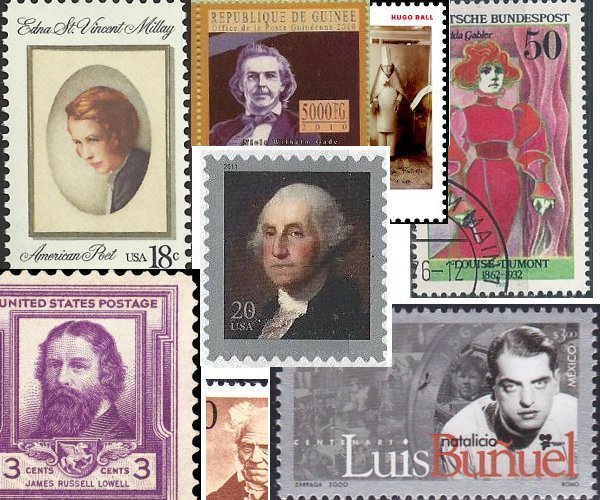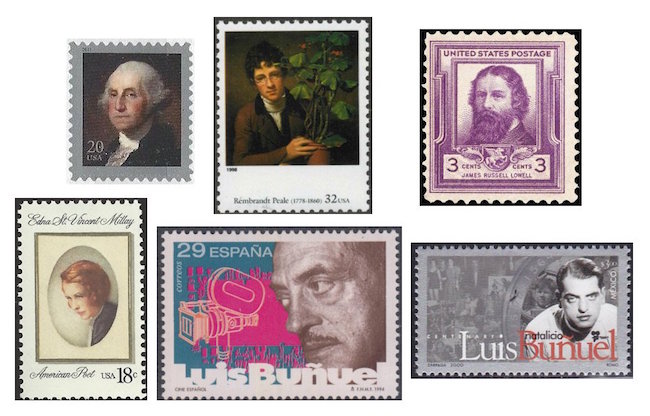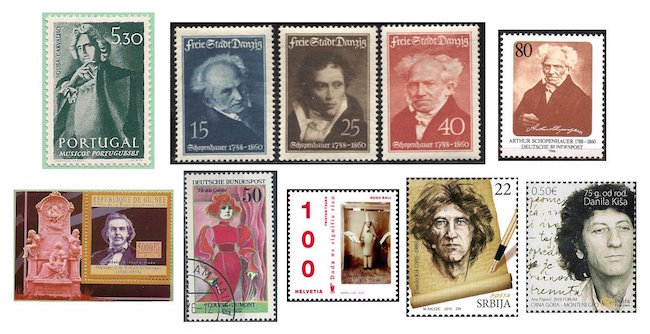The Arts on the Stamps of the World — February 22
An Arts Fuse regular feature: the arts on stamps of the world.

By Doug Briscoe
In one of those funny coincidences, American portrait painter Rembrandt Peale (1778 – October 3, 1860) happened to have the same birthday as his subject George Washington (1732). His father Charles Willson Peale painted Washington a number of times, as we’ll see on the elder Peale’s birthday in April. Rembrandt Peale’s Washington was painted in 1795, and he was never entirely satisfied with it. In 1824, long after the President’s death, Peale revisited the subject with his Patriae Pater; certainly there must be a stamp of this somewhere, but I can’t find it. He was a prolific painter and also a museum curator—in 1814 he founded what has since 1981 been known as the Peale Museum in Baltimore. Peale also made a very famous portrait of Jefferson.
Another central figure in American arts was James Russell Lowell (1819 – August 12, 1891), not much read these days, but a name to conjure with once upon a time as a poet and essayist. Cambridge born, he was a Harvard grad, earning a law degree, and later supervised the Modern Languages Department there. In the meantime he became friends with Emerson, wrote poems, married, and grew staunchly abolitionist. Naturally depressive, Lowell often harbored suicidal thoughts, particularly on the deaths of his infant children, his mother, and his first wife. His first success was with A Fable for Critics (1848), in which he poked fun at his fellow writers. His literary lectures were also very well received. He became the first editor of The Atlantic Monthly in 1857, a position he held until 1861. In the following decade he embarked on a political and diplomatic career, serving as minister to Spain and England, where he became the godfather to Virginia Woolf. Lowell is buried in Mount Auburn Cemetery.
On to our third American and our second poet, Edna St. Vincent Millay (1892 – October 19, 1950), a Maine native. Familiar with classic literature from childhood, she was a published poet at 15. After attending Vassar she went to New York and in 1924 was a co-founder of the Cherry Lane Theater. The year before, she had won the Pulitzer Prize for Poetry and had married, though Millay continued to have other lovers of both sexes. Besides her poems, she composed several verse dramas and the libretto for Deems Taylor’s opera The King’s Henchman, which was heard at the Met in 1927.

Today is the 117th anniversary of the birth of the great Spanish director Luis Buñuel (1900 – 29 July 1983). In youth he formed a close friendship with two other Spanish titans, Salvador Dalí and Federico García Lorca. It was only in his twenties in Paris that Buñuel turned to filmmaking (he acted as assistant director for a film starring Josephine Baker), creating a stir with his very first independent effort, the landmark short Un Chien Andalou (1929), a collaboration with Dalí. His next project was the notorious and long-suppressed L’Age d’Or (1930). Buñuel’s first features were made in Mexico; from that period (1947-1955) the most celebrated films are probably Los olvidados and El bruto. After 1955, Buñuel became a more widely international director, making movies also in France, Italy, the USA, and Spain, as well as continuing his work in Mexico. His last half dozen films, for all of which Buñuel had a hand in writing the screenplays, are all treasures, Belle de jour (on a novel by Joseph Kessel), The Milky Way (1969), Tristana (1970), The Discreet Charm of the Bourgeoisie (1972), The Phantom of Liberty (1974), and That Obscure Object of Desire (1977).
February 22 is also the birthday of Portuguese composer João de Sousa Carvalho (1745 – c. 1798). He wrote much sacred music as well as operas, one of which, Testoride (1780), was revived in 1987 and recorded under René Clemencic in 2009. His keyboard works have also been recorded by such artists as Felicja Blumental. Regarded as the preeminent Portuguese composer of his time, he served at the Seminário da Patriarcal in Lisbon and was music teacher to the royal family.
As a nod to those who may regard philosophy as an art of sorts, we post some stamps honoring Arthur Schopenhauer (1788 – 21 September 1860), including a set of three issued by the free city of Danzig, a geopolitical entity that existed between 1920 and 1939.
Niels Wilhelm Gade (I gather his name is pronounced like “gather”) was born two hundred years ago today. Son of an instrument maker, Gade (1817 – 21 December 1890) started out as a violinist in the Royal Danish Orchestra. He submitted his first symphony for a performance in Copenhagen, and on its refusal Gade, undaunted, sent it to Mendelssohn, who not only liked it, but presented it to the Leipzig public in 1843, and they liked it, too. Gade went on to write seven more, plus works in other genres, excluding opera and liturgical music. (One of his other works is a Bridal Waltz that has become an indispensable element at Danish weddings.) Gade and Mendelssohn (Schumann, too) became friends after Gade moved to Leipzig to teach at the Conservatory and work as an assistant conductor of the Gewandhaus Orchestra. It was Gade who conducted the first performance of Mendelssohn’s great Violin Concerto in E minor. When Mendelssohn died in 1847, Gade took over as chief conductor but had to give it up the next year when war broke out between Prussia and Denmark. Back home, Gade became director of the Copenhagen Musical Society and co-director of the Copenhagen Conservatory and worked as an organist. His students included Grieg and Nielsen. Apparently his friendship with Schumann was enough reason for the designer of this souvenir sheet from the Republic of Guinea to place Gade’s portrait on an issue ostensibly honoring Schumann. Apparently Denmark has no plans to mark the bicentenary stamp wise.

The German actress and theater director Louise Dumont (1862 – 16 May 1932) was born Louise Maria Hubertine Heynen. She auditioned in 1882 at the Residenz Theater in Berlin and decided to tread the boards using her mother’s maiden name. Dumont was engaged at the Royal Court Theatre in Stuttgart from 1881 to 1898, thereafter having her greatest triumphs with the Ibsen performances she gave at the Deutsches Theatre in Berlin. She and her husband-to-be Gustav Lindemann founded a theater in Düsseldorf. After their separation in the 1920s, Dumont took a number of young actresses, including Luise Rainer, under her wing. It is thought that they were likely Dumont’s lovers.
In his twenties the German writer Hugo Ball (1886 – 14 September 1927) worked as an actor with Max Reinhardt. His opposition to World War I made him persona non grata in Germany, and he removed with his wife-to-be Emmy Hennings to Switzerland. A philosophy student with an interest in anarchism, Ball created the Dada Manifesto in 1916. The stamp shows him reading his nonsense poem “Karawane”, an early example of sound poetry, also written in that year. “Karawane” is the basis of a recent composition for chorus and orchestra by Esa-Pekka Salonen. Talking Heads fans may recognize Hugo Ball’s name from the group’s song “I Zimbra”, based on his poem “Gadji beri bimba”, on their 1979 Fear of Music album.
Our final subject for today is the Serbian writer Danilo Kiš (1935 – 15 October 1989), a great admirer of Bruno Schulz, Borges, and Nabokov. He was the son of a Jew named Kon who had changed his name in accordance with the practice of Magyarization prevalent in the late 19th century. Danilo’s father and several other family members were Holocaust victims, while he and his mother survived in Hungary. They returned to Yugoslavia after the war. Kiš was the first student to earn a degree in comparative literature from University of Belgrade. After working as a journalist, Kiš published two novels in 1962. His 1973 novel Peščanik (Hourglass) was made into a film in 2008.
A graduate of the University of Massachusetts with a B.A. in English, Doug Briscoe worked in Boston classical music radio, at WCRB, WGBH, and WBUR, for about 25 years, beginning in 1977. He has the curious distinction of having succeeded Robert J. Lurtsema twice, first as host of WGBH’s weekday morning classical music program in 1993, then as host of the weekend program when Robert J.’s health failed in 2000. Doug also wrote liner notes for several of the late Gunther Schuller’s GM Recordings releases as well as program notes for the Boston Classical Orchestra. For the past few years he’s been posting a Facebook “blog” of classical music on stamps of the world, which has now been expanded to encompass all the arts for The Arts Fuse
